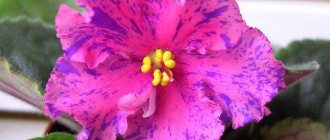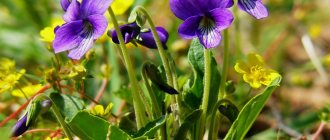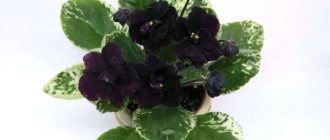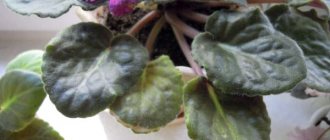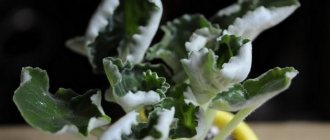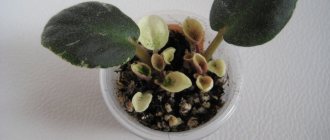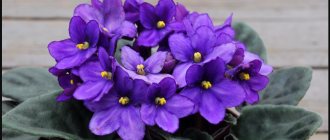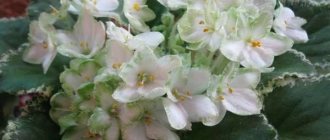Variegated Violet is very loved by many gardeners for its beauty and unusual appearance. The flower continually surprises with its charm. These violets come in a variety of varieties; they are suitable for landscape design, as well as for home decoration, photo shoot areas, summer cottages, and will also add beauty to greenhouses.
By its appearance we can say that the Variegated Violet flower is amazing and attractive. Judging by the color, we can say that the plant is also diverse, there may be the usual green tint, but there may be yellow, ocher and fuchsia, you can also find a plant with white leaves.
Violet Variegated: variety description and characteristics
Variegated violet: photo of variety
Experts have long wondered why there is such an unusual and varied color on violet leaves? This is because the plant reproduces from its own seeds and the creation of new ones occurs, mutation of flowers.
The birthplace of the variegated violet is the United States of America, the mid-twentieth century. The plants developed variegated immediately, and this could not be removed in any way. Initially, violets have one or a couple of leaves of different colors. Thus, the flower was not popular at gardening gatherings because no one knew what color it would be when it grew.
It must be said that after such exhibitions, the plant variety was given a new name “Spontaneous Selection”. Variegated leaves were rarely passed down from generation to generation. Their color, it always changes, reaches a dense green.
This mutation occurs at high humidity and temperature in the room where violets are grown, as well as due to the large amount of nitrogen in the nutrients. Varieties of color can be as follows: soft pink, acidic, ocher.
Variegated violet: varieties with names and photos
Variegated violet: photo of variety
At the moment, we can already count up to four thousand different types of violets. Experts studied a large number of variegated leaves, even created a magazine with violets, which shows the three main types of plants:
- Tommy Lowe Variegation is the name of the plant after its creator. Most of the leaves are green in color, along the edges there is a small outline from yellow to pinkish. The color of the plant may be different, depending on the growing conditions. Light is not dangerous for this violet due to its large accumulation of chlorophyll. It can be propagated by cuttings, like all flower varieties. This method allows for rapid reproduction, all on time.
- Crown variegation is not such an attractive crop. The leaves are pale, green, sometimes pink in color, as the inflorescence passes, the leaves disappear, and new ones appear in place. The peculiarity of violets is that the leaves closer to the ground are a green, uniform, dense color, and those that grow higher can be yellow. It can also be propagated by cuttings. This plant requires special and regular care. They always need lighting, and when they reproduce, the babies need more warmth and moisture.
- Mosaic variegation is an exception flower, a miracle of nature. It can be found in exceptional places, that is, it is not a common plant like the others. On its leaves you can see spots, bright in color, not only of older, but also of younger plants. The shade of the leaves of this violet can be varied at one time. In order for the plant to be comfortable, it is grown at temperatures from eighteen to twenty-five degrees, it is imperative to ensure that there is a lot of light. Also, the flower does not tolerate hot weather, so it should be moistened. The inflorescence appears later, not like other violets.
- Chimera - this variety has a clear pattern on all leaves. The pattern on the leaves can be dull or bright. This variety is not common, because its propagation is possible only by stepsons that form directly in the flower. But their heredity is not exact. The peculiarity of the plant is in its composition. Under a microscope you can see that the petals are two-layered, one green is the main one, and the other seems to be superimposed on top - light green.
Caring for a plant at home
Caring for violet EK-Orange Slices at home does not require a lot of time, effort and money:
- Watering. For proper watering, the water is allowed to sit for at least 24 hours in an open container to ventilate the chlorine present in tap water. The optimal temperature for watering is room temperature or slightly higher.
Saintpaulia should be watered using a wick.
Advice! Experienced flower growers do not recommend using melted snow or rainwater due to poor ecology.
You can water from above , using containers with a long horn, so that the leaves and especially the center of the plant remain dry. If moisture gets on the plant, blot it with paper napkins. The need for watering is determined visually. The soil should dry 1 cm.
Another method of watering is through a tray . It is important to pour as much liquid as the orris root can absorb.
When using wick watering, the fabric is inserted into the pot through the drainage holes. On the other hand, it is lowered into a container of water. Place the pot on the container so that it does not touch the water. Watering is carried out using a damp cloth;
- Feeding . Violets are fed during the period of active growth once every 10 days with the usual formulations for flowering plants. Fertilizers are diluted, reducing the concentration by 2 times. You cannot overfeed Saintpaulia EK-Orange Slices, otherwise it will become fatty:
- All the power will go into the foliage;
The rosette will grow large.
For the same reason, nitrogenous fertilizers should be limited ;
- Peduncles become long;
The leaves lift up and become dull;
To correct the situation, 36 W fluorescent lamps are additionally used. On hot summer days, violets provide shade:
- Film;
- Tulle;
- Or white paper.
Violets on the windowsill need to be shaded and additionally illuminated.
Sun rays can cause :
- Burns on leaves;
- Reducing the size of flowers;
- Rapid fading;
- Leaf bend down;
- Deformation.
IMPORTANT! Saintpaulias survive the heat worse - the flowers fade, quickly fade or do not bloom at all.
You can help on hot days by placing the pots on trays with moistened expanded clay . In the heat, plastic bottles with ice are placed between the plants;
- The recommended humidity for comfortable life of Saintpaulia is 50-55%. At low humidity, the plant slows down its growth and development. High air humidity leads to rotting of violets;
- Plant hygiene . To make EK-Orange slices look chic, hygiene procedures are carried out in a timely and regular manner: Dried flowers are removed along with the flower stalks;
- The lower leaves are removed, forming a neat rosette;
- Remove yellowed leaves;
- If the stem is very bare, it is sprinkled with earth;
- The stepsons clean up.
- Leaves;
It is better to replant violets once a year.
- Natural;
Forest;
to it :
- Peat;
- Biohumus;
- Vermiculite.
The main requirement for the composition is pH 5.5-6.5 . Acidity can affect the color of the petals, making it darker or, conversely, lighter;
- Cut with a scalpel, leaving a stem at least 1 cm long with 5-6 leaves, remove all flower stalks;
Place the stem in water until roots appear;
The required time is 2-3 weeks .
Variegated Violet: care
Variegated violet: photo of variety
To preserve the color of variegated violet petals, you need to know some criteria:
- Violet soil needs to have some nitrogen in it, unlike other soils for growing the plant.
- Lots of light. You can add additional lighting, but it should not be direct, because some leaves may burn in direct rays.
- Room temperature - some plants do not like hot weather, for example, at high temperatures above twenty-eight degrees the petals fade.
The upper leaves are less adapted to life because they contain little chlorophyll. Thus, in order to better propagate the plant, it is necessary to use leaves that are closer to the ground.
It happens that the plant is completely variegated, it needs to be fed with nitrogen and useful substances so that the plant becomes stronger.
Reviews
Olesya. “I liked the very warm, delicate, unusual orange flowers at first sight. The rosette of the young plant did not look very neat, but with age it got better and became very pretty.”
Galina. “Violet EK-Orange Slices did not disappoint. Dark leaves set off the delicate flowers very favorably. The color of the petals is amazing, orange! An even, collectible rosette makes the flower bush even more elegant.”
Maria. “I was so lucky - I easily got my masterpiece from a simple piece of paper. It took root quickly and grew without problems. Already pleases with cap blooms.”
This variety attracts with its wavy shape.
